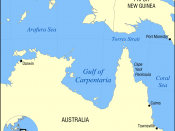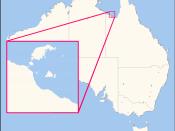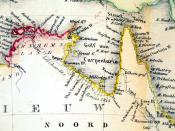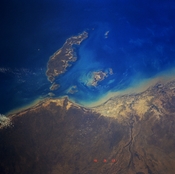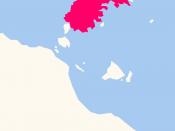Generalisations about Aboriginal culture are what we use to create stereotypes, give quick explanations etc. But how far can we really generalize about these people? We can when we are generalising broadly but not when we cross that line from broad to specific. The ensuing focuses will be on economic, social and spiritual practices, with examples mainly from two tribes: the Nyungar of modern-day Albany (SW corner of WA) and the Lardil of Mornington Island in the Gulf of Carpentaria, QLD.
One generalisation we can sustain is that all Aboriginal tribes based their hunting on an intimate knowledge of the land. For example, the Nyungar tribe used a special ÃÂfire & dogÃÂ method in the dense forests ÃÂtdurrinÃÂ on their land. They would set fire to a section, then the ÃÂtoort-a-dinÃÂ (dog owners) and their tamed dingoes would go andHide in the animals escape paths. As the animals couldnÃÂt see them through the smoke and were too panicked to use their senses, they became easy victims of thrown spears and pouncing dogs.
For this method to have been successful the Aboriginals would have to know the wind direction and the likeliness of it changing, how the forest would burn so as to control it and the paths the animals would take in flight. A second example would be the method in which the Lardil people caught the ÃÂdà «lnà «Ã fish. For just our month of September the Lardil knew their sacred dà «lnà « fish would be off their shores. They used an open-ended v-shaped net to catch it as they knew it had good hearing but bad eyesight. These both support the generalisation of and intimate knowledge of their environment was the basis of their hunting; however, the details are specific to their own environment, if you re-located them to somewhere else they may die.
A second generalisation made is that all tribes put their ÃÂyoung adultsàthrough an initiation. Examples can be found in the initiation of boys from the Nyungar and Lardil tribes. Nyungar boys began with a ceremony held by their ÃÂMulgarradockà(doctor), where the Mulgarradock would work a sharpened length of kangaroo bone through the septum of their noses; their fatherÃÂs would stand behind holding their head to keep them in position. Following this, the boys left their families for a period of time that could last for several years; two men would take them to another family each year. During the year with a family under a seniorÃÂs supervision, they learnt about physical and social environment surroundings consisting of tough tests. During their stay they may also become ÃÂblood brothersàwith a good friend, or be promised a new infant for a first wife. They became men when the bone was removed and this was usually around the age of thirty. For the Lardil boysàthe first stage of initiation, ÃÂLà «rà «guÃÂ, consisted of them only being able to speak ÃÂDarminà(a secret language used only by initiation men that consisted of sounds rather than words) and for some months; had to stay away and look after themselves. The rest of their initiation process consisted of a series of event with learning, ceremonies and finally circumcision. Circumcision was very important to them as pain and discomfort taught discipline and endurance. Again, these examples support the generalisation of initiation but the specifics cannot be generalized as they are too varied.
A third generalisation made is that marriages were regulated to skin-groups. These skin-groups were an effective way of preventing in breeding in a culture with no last names etc. The Lardil had eight skin-groups in total and a complex system for marriage and which group the children would be. This is more easily deciphered in this table:Lardil Marriage PatternManWomanChildSkin-group 1 (Ngari-Bodà «ngi) & 5 (Burulà «ngi)Ngari-Bodà «ngiBurulà «ngiBà «ngaringiBurulà «ngiNgari-Bodà «ngiGà «merà «ngiSkin-group 2 (Bà «ngaringi) & 8 (Yà «gà «mari)Bà «ngaringiYà «gà «mariNgari-Bodà «ngiYà «gà «mariBà «ngaringiGà «ngà «llaSkin-group 3 (Bulà «nyi) & 7 (Gà «ngà «lla)Bulà «nyiGà «ngà «llaBulyariniGà «ngà «llaBulà «nyiYà «gà «mariSkin-group 4 (Bulyarini) & 6 (Gà «merà «ngi)BulyariniGà «merà «ngiBulà «nyiGà «merà «ngiBulyariniBurulà «ngiLardil marriages were also beneficial for the womanÃÂs family whilst growing up as her promised husband would bring food and gifts until as a form of ÃÂarranged courtshipÃÂ. Nyungar people only had two skin-groups, ÃÂErniungàand ÃÂTemÃÂ. It was quite simple that one had to marry the other. The men would marry usually around the age of thirty, whereas women married as soon as they reached puberty (as they had been promised since infancy). Also Nyungar man may have up to four wives in his lifetime. This definitely shows and supports that marriages were regulated to prevent inbreeding through the method of skin-groups. Although, depending on the tribe size and circumstances, the specifics of complexity etc are varied greatly.
At the beginning of this essay I made the declaration that yes you can generalise about traditional Aboriginal culture, but only on a broad spectrum. Through exploration and elaboration of a few generalisations on the economic, social and spiritual parts of their lifestyle a pattern started to occur. This pattern being the generalisation was supported but the details of the examples were vastly different, like the Lardil peopleÃÂs eight skin-groups as opposed to the NyungarÃÂs two. Thus coming to a conclusion that co-insides with my conjecture.
Bibliography1. My own personal notes from watching movies in class and massive handouts from teacher.
